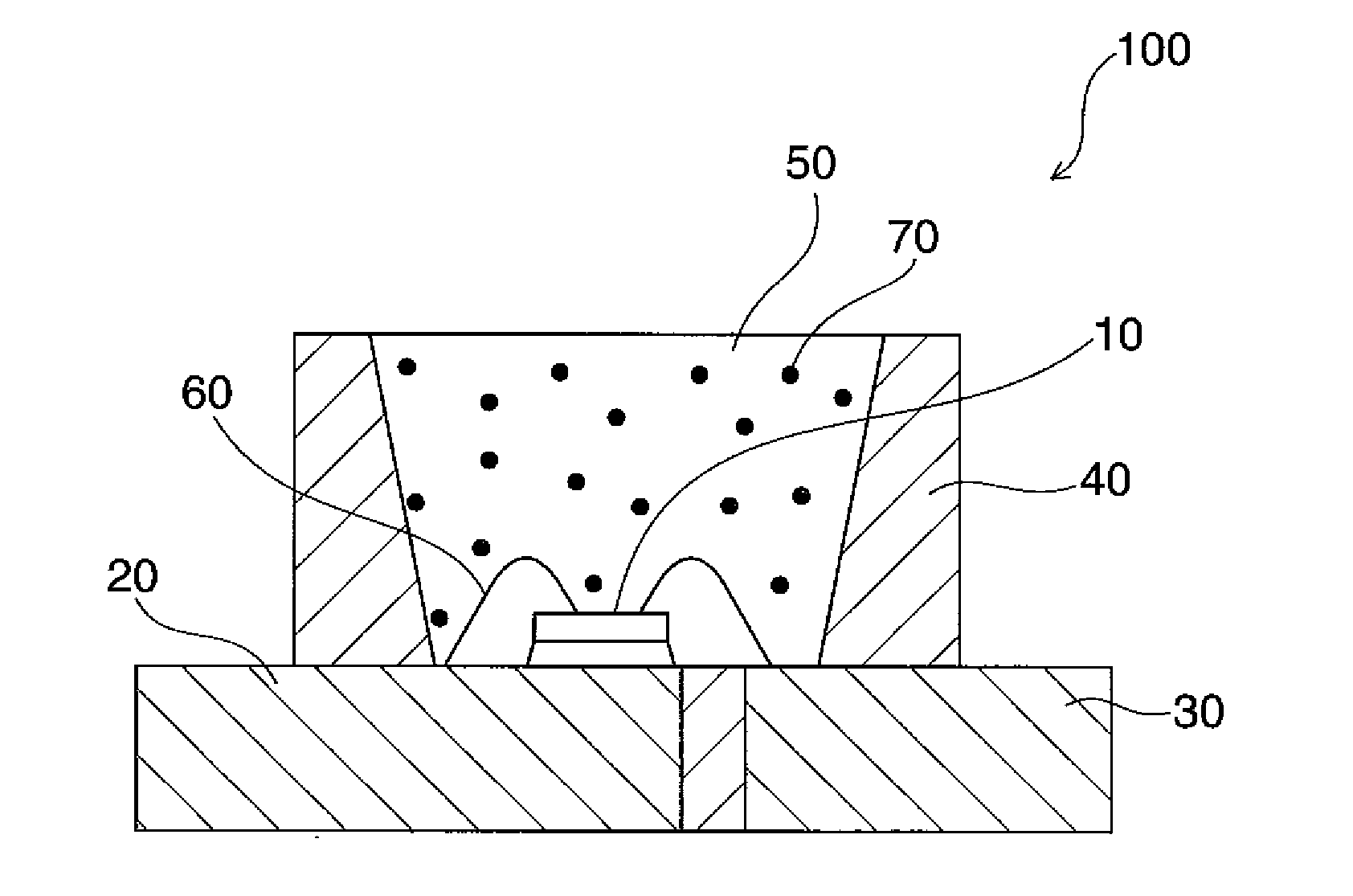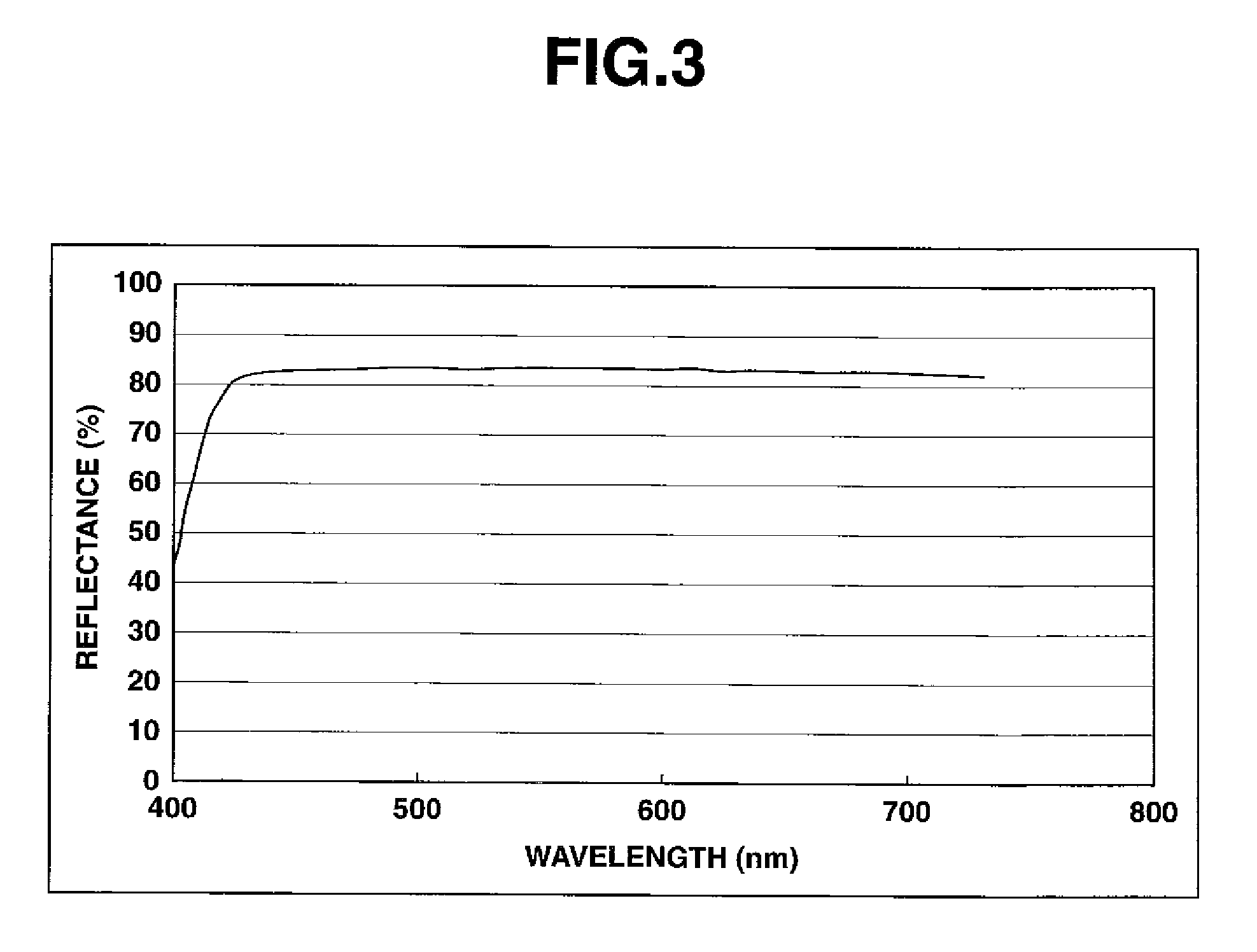Light-emitting device, method for manufacturing same, molded body and sealing member
a technology of light-emitting devices and moldings, which is applied in the direction of synthetic resin layered products, chemistry apparatuses and processes, layered products, etc., can solve the problems of poor adhesion of resins to leads and sealing members, resins that use silicone resins lack long-term reliability, and prior art thermoplastic resins used as moldings in surface-mounted light-emitting devices are less resistant to light, etc. , to achieve the effect of adversely affecting
- Summary
- Abstract
- Description
- Claims
- Application Information
AI Technical Summary
Benefits of technology
Problems solved by technology
Method used
Image
Examples
example
[0092]Examples and Comparative Examples are given below for further illustrating the invention although the invention is not limited to these Examples.
examples 1 to 10
[0093]Of the components shown in Table 1, the epoxy resin, acid anhydride and antioxidant were previously melt mixed on a reactor at 100° C. for 3 hours. The mixture was cooled for solidification (softening point 60° C.), ground, and thereafter compounded with other components in the predetermined compositional ratio. This was uniformly melt mixed on a hot twin-roll mill, cooled, and ground, yielding a cured product of a white epoxy resin composition serving as a molded part for use in a light-emitting device. The starting materials used herein are described below.[0094](A) Epoxy resin[0095](A-1) Triazine Derived Epoxy Resin[0096](i) Tris(2,3-epoxypropyl) isocyanate (trade name TEPIC-S by Nissan Chemical Industries, Ltd., epoxy equivalent 100)[0097](A-2) Hydrogenated epoxy resin[0098](ii) Hydrogenated bisphenol A type epoxy resin (trade name YL-7170 by Japan Epoxy Resins Co., Ltd., epoxy equivalent 1200)[0099](iii) Hydrogenated biphenyl type epoxy resin (trade name YL-7040 by Japan ...
example 11
[0127]Example 11 demonstrates a light-emitting device. In the light-emitting device of Example 11, an epoxy resin composition according to the invention is molded to form a molded part on a leadframe of copper alloy by a transfer molding technique. The molded part is provided with a recess having bottom and side surfaces. A light-emitting element of blue emission comprising a sapphire substrate and a light-emitting layer of InGaN is mounted using an epoxy resin adhesive. The light-emitting element is electrically connected to the leadframe using gold wires having a diameter of 30 μm. A sealing member is applied dropwise into the molded part with the recess on the bottom surface of which the light-emitting element is mounted. The sealing member used contains 100 parts by weight of a silicone resin, 30 parts by weight of a YAG phosphor, and 5 parts by weight of a light diffuser of silicon oxide. It is heated from room temperature to 150° C. over 3 hours, and cured at 150° C. for 5 hou...
PUM
| Property | Measurement | Unit |
|---|---|---|
| emission peak wavelength | aaaaa | aaaaa |
| reflectance | aaaaa | aaaaa |
| softening point | aaaaa | aaaaa |
Abstract
Description
Claims
Application Information
 Login to View More
Login to View More - R&D
- Intellectual Property
- Life Sciences
- Materials
- Tech Scout
- Unparalleled Data Quality
- Higher Quality Content
- 60% Fewer Hallucinations
Browse by: Latest US Patents, China's latest patents, Technical Efficacy Thesaurus, Application Domain, Technology Topic, Popular Technical Reports.
© 2025 PatSnap. All rights reserved.Legal|Privacy policy|Modern Slavery Act Transparency Statement|Sitemap|About US| Contact US: help@patsnap.com



